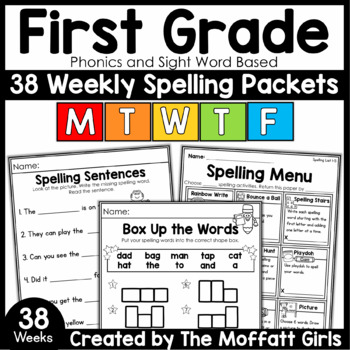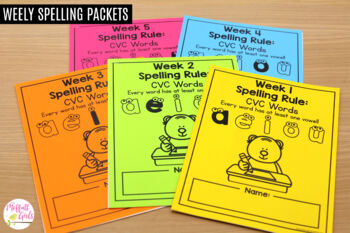First Grade Spelling Curriculum (Phonics and Sight Word Based) 38 Weeks
- Zip
What educators are saying
Description
Weekly Spelling Packets! Get ready to transform your weekly spelling routines! No more random list of words! This fun, hands-on and engaging 38 Week Spelling Program focuses on phonics and sight words!
***DOWNLOAD THE PREVIEW TO SEE THIS CURRICULUM UP CLOSE!
2nd Grade Spelling Curriculum HERE
3rd Grade Spelling Curriculum HERE
What is Included?
- 38 Weeks of Spelling packets Monday - Thursday practice/ Friday Test
- Home Connection Parent and Friends Letter
- 11 Spelling Menus - one for each new Phonics Skill
- Packets Covers with the Spelling Rule
- Flashcards for each List
- A variety of Spellings Lists with the Spelling Rule
How are the Word Chosen?
Words 1-6: Phonics Based Spelling
The first 6 words each week are focused on a phonics skill or spelling rule. Like phonics-based reading instruction, phonics-based spelling builds a deep understanding of the patterns in words. As a result, students will not need to learn to spell one word at a time. Instead, they will learn patterns that they can apply to any word. With phonics-based spelling students will systematically and incrementally improve their ability to spell both simple and complex words.
Words 7-10: Sight Words
The final 4 words each week are sight words. Sight words are the most used words in the English language. Being able to fluently write these words is key to students developing effective written communication.
By the end of the year students will cover the Pre-Primer, Primer, and First Grade Dolchsight words. Together these 133 words make up more than half of the words we read and write. Mastering these basic words will allow students to focus their writing efforts on formulating ideas and spelling tricky words.
Note: There are some review weeks that do not include sight words.
Ways to use this Curriculum:
Traditional Weekly Spelling Homework & Assessments
- Assign students one word list a week.
- Send home a weekly spelling menu and packet. Families can choose activities they enjoy to practice the words and promote a strong school-home connection.
- Assess your students at the end of the week with one of the provided spelling test templates.
Traditional Weekly Spelling & Assessments
- Assign students one word list a week.
- Use the provided activities throughout the week for fun hands-on practice.
- Assess your students at the end of the week with one of the provided spelling test templates.
Word Study & Centers
- Practice the words together each day in morning meeting.
- Use the provided activities for centers, morning work, or seat work throughout the week.
Extension or Intervention
- Use this curriculum as an extra challenge for advanced kindergarten students.
- Use this curriculum as intervention for older students in need of extra phonics and sight word practice.
Weekly Breakdown and Overview
Week 1: Spelling Rule: CVC Every word has a least one vowel
- Focus: Short a
Week 2: Spelling Rule: CVC Every word has a least one vowel
- Focus: Short e
Week 3: Spelling Rule: CVC Every word has a least one vowel
- Focus: Short i
Week 4: Spelling Rule: CVC Every word has a least one vowel
- Focus: Short o
Week 5: Spelling Rule: CVC Every word has a least one vowel
- Focus: Short u
Week 6: Spelling Rule: Silent e Silent e makes the vowel say its name
- Focus: a_e and i_e
Week 7: Spelling Rule: Silent e Silent e makes the vowel say its name
- Focus: o_e and u_e
Week 8: Review Week (CVC and Silent e Words)
Week 9: Spelling Rule: Digraphs & Trigraphs Letters working together to make one sound
- Focus: th and ph
Week 10: Spelling Rule: Digraphs & Trigraphs Letters working together to make one sound
- Focus: sh and wh
Week 11: Spelling Rule: Digraphs & Trigraphs Letters working together to make one sound
- Focus: ch and tch
Week 12: Spelling Rule: Digraphs & Trigraphs Use ck to make the c sound after a short vowel & qu (stick like glue)
Week 13: Spelling Rule: Blends blend together but both of their sounds can still be heard
- Focus: L Blends and R Blends
Week 14: Spelling Rule: Blends blend together but both of their sounds can still be heard
- Focus: S Blends and T Blends
Week 15: Spelling Rule: Blends blend together but both of their sounds can still be heard
- Focus: ng
Week 16: Spelling Rule: Blends blend together but both of their sounds can still be heard
- Focus: ng
Week 17: Spelling Rule: Vowel Teams When two vowels are together the first one says its name (long sound). The second one is silent.
- Focus: ai (beginning or middle) & ay (end)
Week 18: Spelling Rule: Vowel Teams When two vowels are together the first one says its name (long sound). The second one is silent.
- Focus: ea (beginning, middle or end), ee (middle or end) & ey (end)
Week 19: Spelling Rule: Vowel Teams When two vowels are together the first one says its name (long sound). The second one is silent.
- Focus: ie
Week 20: Spelling Rule: Vowel Teams When two vowels are together the first one says its name (long sound). The second one is silent.
- Focus: oa (beginning or middle) & oe (end)
Week 21: Review Week: Digraphs, Trigraphs, Blends, Vowel Teams
Week 22: Spelling Rule: Bossy R: When a syllable has a vowel that is followed by r, the vowel is “controlled” by the r and makes a new sound.
- Focus: ar and or
Week 23: Spelling Rule: Bossy R: When a syllable has a vowel that is followed by r, the vowel is “controlled” by the r and makes a new sound.
- Focus: er, ir, and ur
Week 24: Spelling Rule: Y as a Vowel
- Focus: 1 syllable- y says i, 2 syllables- y says e
Week 25: Spelling Rule: Diphthongs and Special Cases
- Focus: Ow as long o
Week 26: Spelling Rule: Diphthongs and Special Cases
- Focus: ou (beginning & middle) & ow (end & followed by l/n)
Week 27: Spelling Rule: Diphthongs and Special Cases
- Focus: Oi (middle) oy (end)
Week 28: Spelling Rule: Diphthongs and Special Cases
- Focus: short oo
Week 29: Review Week Diphthongs and Special Cases
Week 30: Spelling Rule: Diphthongs and Special Cases Continued
- Focus: /oo/ sound- oo& ui (mostly in the middle)
Week 31: Spelling Rule: Diphthongs and Special Cases Continued
- Focus: /oo/ sound- ew, ue, u_ e (mostly at the end)
Week 32: Spelling Rule: Diphthongs and Special Cases Continued
- Focus: igh
Week 33: Spelling Rule: Diphthongs and Special Cases Continued
- Focus: Au & aw
Week 34: Spelling Rule: Soft Consonants
- Focus: Soft c (ce, ci, cy)
Week 35: Spelling Rule: Soft Consonants
- Focus: Soft g (ge, gi, or,gy)
Week 36: Spelling Rule: fszl Rule: f, s, z, and l are usually doubled at the end of 1 syllable words
- Focus: ff & ll
Week 37: Spelling Rule: fszl Rule: f, s, z, and l are usually doubled at the end of 1 syllable words
- Focus: ss & zz
Week 38: Review Week
More Questions?
Feel free to email me at themoffattgirls@gmail.com
Be sure to follow the Moffatt Girls on:
- Visit my blog at The Moffatt Girls Blog
- Follow me on Facebook
- Follow me on Instagram
- Join my FREE private group, The Moffatt Girls-Engage Group, to see how other teachers, parents, and homeschoolers are using and organizing Moffatt Girl Curriculum!





